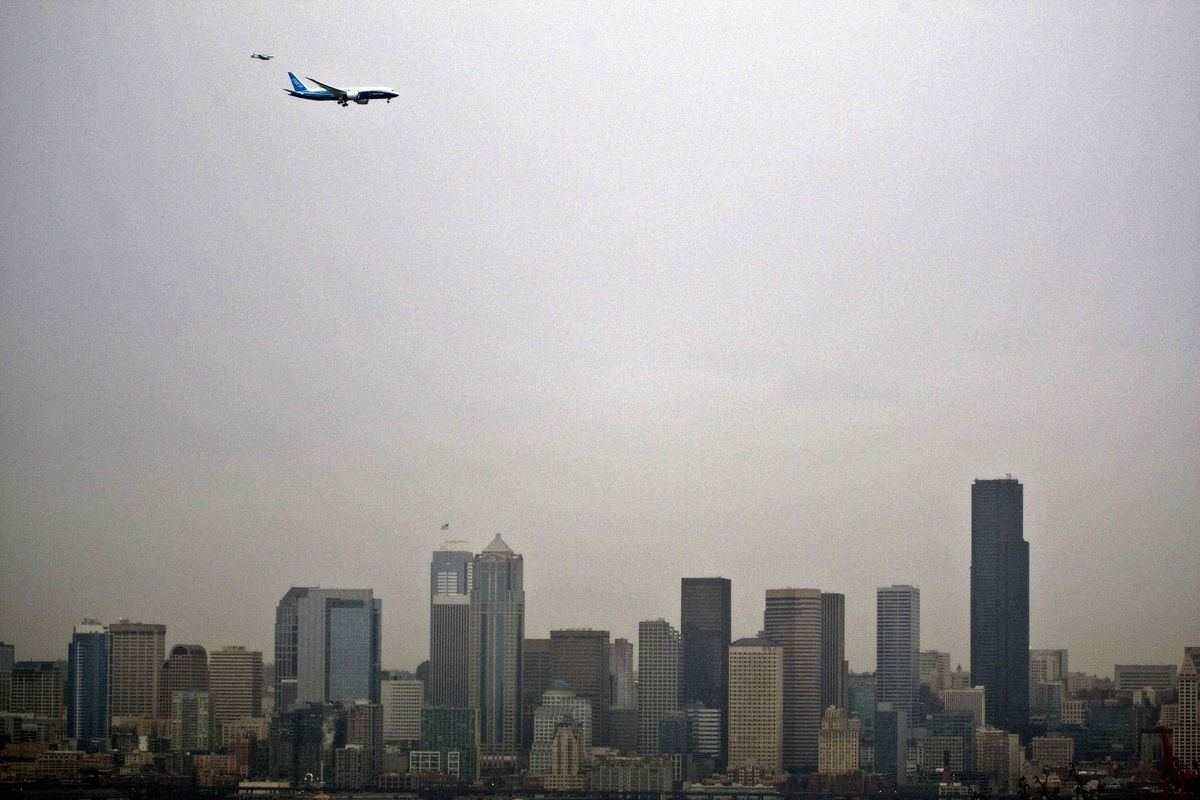Test pilot tames Boeing’s new monster
Carriker banks on experience as he puts 787 through the paces

SEATTLE – In Boeing test pilot Mike Carriker’s military and commercial flying career, what he calls “the funnest moments” came when he turned a fighter jet upside down and spun it like a top as it descended.
The worst moment was ditching into Elliott Bay in a Boeing Stratoliner.
“Spinning an airplane upside down at 35,000 feet, going around madly, gets your thoughts squared away,” Carriker said.
In the next nine months, as Carriker leads Boeing’s newest airplane through a rigorous series of flight tests, he’ll frequently draw upon an ability developed through all that spinning: to keep cool, gather data and maneuver with precision during heart-racing moments of tension.
As for the ditching – “hopefully a never-to-be-repeated event” – he’ll take a lesson he learned then into the coming flight tests.
On Tuesday, Carriker and Boeing engineering test pilot Randy Neville took Boeing’s crucial, hot-selling 787 on its first flight.
Carriker and a team of more than three dozen 787 test pilots aim to give Boeing’s engineers the results they want and the company the success it sorely needs, after more than two years of delay in getting the first airliner built mostly of composite plastic into the air.
Carriker recalls the first time he practiced a spin in a small airplane over Kansas farmland as a teenage student pilot, thinking, “I’m gonna die. I’m gonna die.”
But as his experience grew, so did his cool.
By the time he was a Navy flight-test instructor, teaching this stuff to other pilots, he could do a lot more than count as he spiraled Earthward. He could locate the jet’s center of rotation from the pressure pushing him back in his seat. He’d look at the wingtips and the horizon to estimate the airplane’s angles of pitch and banking. He’d time the period of rotation. He’d note the altitude lost on each spin.
He won’t have to spin the 787, but he’ll need the same sang-froid.
Carriker, 53, grew up in Wichita, Kan. His father, who had been a Methodist chaplain in the Air Force, took him up in an airplane for the first time. While completing an aeronautical-engineering degree at Wichita State University, he earned his pilot’s license, taking off from an 1,800-foot grass runway.
Despite his progression to hotshot test pilot, Carriker has no trace of swagger.
He arrived for an interview at Boeing’s Dreamliner customer gallery in Everett last spring wearing jeans and a flight-line jacket adorned with crossing-guard-yellow reflective material.
The sleek red convertible parked outside, the one with the B-787 license plate, was the gallery manager’s car, not his. “Mine would be the black F-150 pickup,” he said.
Mike Sinnett, director of 787 systems, got a sense of how Carriker loves his job when the two for a while took the midnight-to-3-a.m. shift manning the 787 flight-deck simulator, which operated around the clock to fit in all the tests needed.
When Carriker was especially enjoying himself, he’d do a little dance in the simulator seat, raising his fists above his head and rocking his arms and upper body.
“Today, you can occasionally see him do the Carriker dance inside the airplane,” Sinnett said.
For the flight tests ahead, Carriker said his focus is on executing them just right so the data that goes into the 787 flight manual will match what Boeing’s engineers expect.
He describes, for example, the precision of the tail-strike test:
As the plane speeds down the runway, the pilot pulls the nose up until the tail actually touches the ground, to get the maximum lift from the tilted wing.
This test establishes the minimum speed at which the plane will leave the ground. The targeted liftoff speed in the airplane flight manual will then be set about 10 percent higher.
“The whole time you are feeling for the tail to go down,” Carriker said. “If you put the tail down too hard, it’s a brake; the airplane won’t accelerate any more. If you don’t get the tail all the way down, you leave performance on the table.”
The test data that goes into the plane’s manual will dictate how airline customers can operate the Dreamliner. And if it means “one less passenger out of Denver on a summer day, that’s a big deal over 30 or 40 years,” Carriker said.
If anything does go awry during the Dreamliner flight tests, Carriker may draw upon experience.
He was the co-pilot in March 2002 when a restored Boeing 307 Stratoliner – a 1940s-era prop plane, the first fully pressurized airliner – embarrassingly ran out of gas on a flight from Everett and ditched into Elliott Bay off Alki Beach.
The airplane was recovered, restored once again, and flown the following year to its current home at the Smithsonian Institution.
For the 787’s first flight, Boeing had to plan for every possibility.
Carriker doesn’t dismiss the unknowns he faces.
“We have a plastic airplane. … It’s the first time anybody in the industry has taken a large composite wing with a composite spar and gone whipping out,” he said. “Obviously, we think we’re OK, otherwise we wouldn’t go fly.”